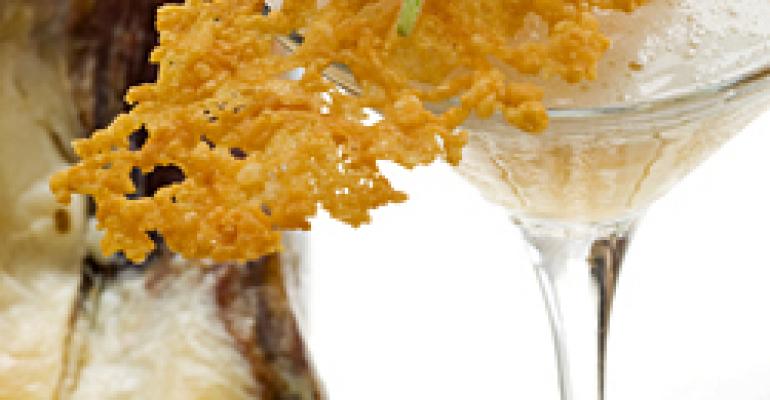Most clever bartenders know a trick or two with fresh juices, herbs and cucumbers. But to be on the cutting edge, you better delve even further into the walk-in.
The boldest barkeeps craft chef-inspired, savory cocktails with ingredients like bacon, ham, beets, mushrooms, cheese and even oysters. The unconventional flavors that ensue are not for everyone, but a surprising number of customers fancy them.
"American palates are constantly looking for new things and accepting new savory ideas," said Eben Freeman, bartender of Tailor in New York City. "Herbs are already an accepted landscape in cocktails, and vegetables have been happening for a number of years as well."
It all started when bartenders strolled into kitchens and walked out with new products and ideas. "It's probably one of the biggest revolutions in mixology around the world — bartenders taking inspiration, advice and leadership from their chefs," declared Naren Young, who tends bar at Bobo, also in New York City.
Freeman credits Sam Mason, chef and partner at Tailor, with much of his cocktail inspiration and even some of his techniques. "He inspired me to explore the use of savory ingredients and vegetables," said Freeman.
Take Beet Sangria, for instance, which starts with basic sangria ingredients like red wine, Spanish brandy, triple sec and orange juice. But it is beholden to fresh raw beets, passed through a vegetable juicer, for its sweet and earthy flavor. Freeman tops it off with ginger beer for added complexity.
Freeman also stepped out with the Mushroom Margarita, based on an infusion of mezcal, a Mexican spirit derived from the agave plant, and huitalacoche, a fungus that grows on corn and is considered a delicacy in Mexico. The inspiration was a cognac-and-truffle drink served at the Ritz Bar in Paris. His infusion turned out dark, smoky, earthy and heady. "It was intended to be something that people would be quite afraid of, so we just served shots behind the bar," said Freeman. "But the response was so surprisingly strong, we decided to try it in a margarita."
People have strong feelings about tasting beets and mushrooms in their cocktails, Freeman allowed. "But I think that whenever a drink is equally rejoiced and reviled, you're on to something good," he said. "There are some people who think it's just the most amazing thing they've ever had."
Unusual ingredients don't shock like they once did, according to Bobo's Young. "Any sort of herbs, stock, beet juice, ginger, cheese — whatever you can possibly think of — is in a cocktail now," he said. His work at Bobo includes a Bloody Lobster drink made with rich lobster stock and a Tiramisu cocktail made creamy by shaking fresh mascarpone cheese.
Meaty flavors are an exciting savory frontier. One standout is a drink called Ham & Cheese at Nacional 27 in Chicago. General manager and bar chef Adam Seger soaked a leg of Spanish Iberico ham in VS Cognac in the walk-in for two weeks. He shook the resultant "ham Cognac" with honey-cinnamon syrup and lime and served it up with a Manchego cheese tuile for garnish.
Abacon cocktail is "an easy sell," declared Peter Vestinos, bartender of Sepia, also in Chicago, who makes a popular Bacon Bloody Mary, made with an infusion of applewood-smoked bacon and vodka. Mixologist Michael Martensen of the Rosewood Mansion on Turtle Creek in Dallas got positive comments about the Apple Bacon Martini, a combination of bacon-infused bourbon, Calvados, German apple schnapps, lemon and sparkling cider, when he tested it recently.
The active principle of such meaty libations is "fat washing," or the solvent action of alcohol on flavors carried in fats, according to Tailor's Freeman. He makes bacon bourbon by soaking rendered bacon fat in bourbon and later chilling it to solidify and remove the fat. Other bartenders have made fat-washed spirit infusions with the likes of foie gras and olive oil, he noted.
John Kinder, head bartender of MK restaurant in Chicago, specializes in sous vide infusions — combinations of spirits and savory ingredients in vacuum-sealed plastic bags slowly cooked at low temperatures in a thermal circulator.
Kinder likes to pair a cocktail of kumamoto oyster-infused neutral spirits or sake, mineral water reduction and lemon juice with a dish of raw sliced yellowtail with pencil asparagus, piquillo peppers and black olive oil. It's a match reveling in "umami," the Japanese term for the fifth taste of savoriness.
"The whole thing opened up with sea life," said Kinder. "To me, nothing sets you up to eat raw fish like some umami. It prepares your palate for what's to come."




